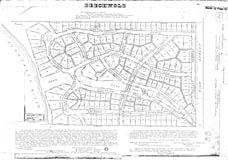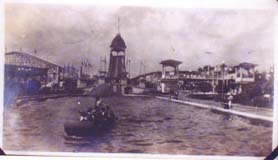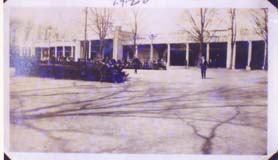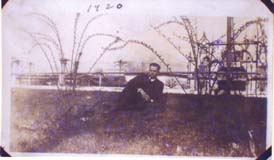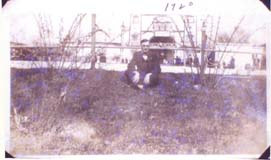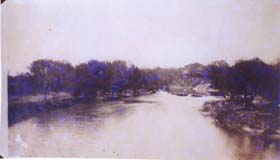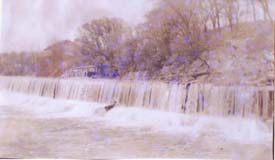‘1900-1940’ Category
And More Markers!
Friday, April 1st, 2016Ron Irick recently alerted me to the Historic Marker Data Base. In it are photographs of several additional markers covering Clintonville’s notable people, places and events. The database includes the marker for Rand Hollenback, on Hollenback Drive at Whetstone Park, the Nat’l Register of Historic Places marker for East North Broadway Historic District, and the marker (currently in Powell) for the Grand Carousel which was formerly at Olentangy Olentangy Park.
Ron recently posted the Clinton Township/Clintonville Historic Marker.
Though not in this database, there is also a marker for the Old Beechwold Historical District. I believe there is also some sort of marker for the former home of the Republican Glee Club at 57 Weber Road.
Arcadia Ave. Apartments
Tuesday, March 15th, 2016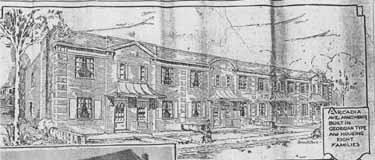
I love this picture of the Arcadia Ave. Apartments, located at 73-93 Arcadia Avenue. The building still exists. When they were first advertised, they were described as a two-story brick building of Georgian type, housing up to 8 families. Each apartment consists of a living room, dining room and kitchen on the first floor, to bedrooms and bath on the second, and a basement laundry. The building was constructed by Galbreath and Leonard, Inc. in 1927. [Image courtesy of Stu Koblentz.]
A. B. Graham House
Friday, January 15th, 2016 A. B. Graham (Albert Belmont Graham) was one of the key founders of the 4-H Club, and was also a leader in developing the nation’s county extension services that are still so helpful to farmers and gardeners and cooks. In his retirement years Mr. Graham lived at 159 Clinton Heights Avenue in Clintonville. (His son lived in Clintonville as well.) The Clinton Heights house is the last surviving house known to be associated with Mr. Graham, and on this basis the house has recently been put on the Register of Historic Places.
A. B. Graham (Albert Belmont Graham) was one of the key founders of the 4-H Club, and was also a leader in developing the nation’s county extension services that are still so helpful to farmers and gardeners and cooks. In his retirement years Mr. Graham lived at 159 Clinton Heights Avenue in Clintonville. (His son lived in Clintonville as well.) The Clinton Heights house is the last surviving house known to be associated with Mr. Graham, and on this basis the house has recently been put on the Register of Historic Places.
You can find more information elsewhere on this web site
The Grand Carousel–Request for Information
Thursday, September 24th, 2015Carousel expert and author Eric Pahlke recently emailed me with a question. The question is about the Grand Carousel that currently operates at the Columbus Zoo & Aquarium.
Eric is trying to resolve some conflicting information about the history of the carousel. He writes,
The oft-repeated story is that the carousel came to Olentangy Park in 1914, and was moved to Scioto Ranch Park in 1937-38 after Olentangy closed. Scioto later became Zoo Park, which became Wyandot Lake Park, which is now a combination of Zoombezi Bay and Jungle Jack’s Landing. I have a source that says the city of Columbus bought the carousel in 1981. The carousel apparently operated at Wyandot Lake until 1999 and has been running at the Zoo since 2000.
The problem is that I have some photographic evidence that says the carousel started on Coney Island and didn’t come to Ohio until the mid-1920s. This alternative story doesn’t distinguish between the carousel then coming to Olentangy Park and then to Scioto, or directly to Scioto.
I’m hoping that someone has materials in their archives that would help solve this dilemma. The primary question is whether the carousel came to Olentangy Park in 1914 or sometime in the 1920s. After that is solved, the other issues probably follow.
Does anyone have any information that could shed light on the issue? Eric is the author of Treasures from the Golden Age: West Coast Carousels, and Treasures from the Golden Age: East Coast Carousels.
Bower & Co. General Store & Family
Tuesday, September 15th, 2015Jim Drake recently contributed these wonderful photos and family histories of the Bower (Weber) family.
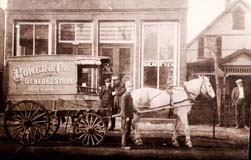 Eda Weber Bower and her spouse, Henry G. Bower owned and operated the Bower & Company General Store at 2643 North High St. The photo to the left shows the store’s delivery wagon and, at the right of the image, a section of the Bower family home at 26 East Duncan Street.
Eda Weber Bower and her spouse, Henry G. Bower owned and operated the Bower & Company General Store at 2643 North High St. The photo to the left shows the store’s delivery wagon and, at the right of the image, a section of the Bower family home at 26 East Duncan Street.
 This photo is the 1901 wedding portrait of Eda Weber (1869-1951), of the historic Frederick Weber family, and Henry Bower (1856-1935). They were married on January 1, 1901.
This photo is the 1901 wedding portrait of Eda Weber (1869-1951), of the historic Frederick Weber family, and Henry Bower (1856-1935). They were married on January 1, 1901.
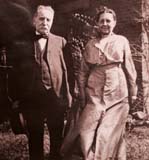 This photo was taken of the Bowers in 1934. In addition to his civic activities, Henry Bower was a founder and principal stockholder in the Northern Savings Bank (which eventually became part of the Huntington Bank system).
This photo was taken of the Bowers in 1934. In addition to his civic activities, Henry Bower was a founder and principal stockholder in the Northern Savings Bank (which eventually became part of the Huntington Bank system).
John J. Bower, one of Henry Bower’s brothers, was initially a partner in the general store, but eventually opened a hardware store on the southeast corner of Duncan and High streets. The Bower brothers are shown in this photo (left to right): Ernest E. Bower, Henry G. Bower, Owen Bower (son of Ernest E.), John J. Bower, his son Everett Bower, and Charles Bower.
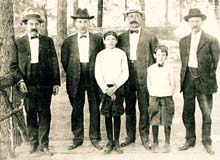
Although Henry Bower had hoped to have at least one son to inherit the general store, he fathered five daughters instead. After his first daughter, Anna, was born, he pre-selected a male name for each successive child, but in every instance he had to opt for a female form of the name.
Consequently, “Albert Bower” became “Alice Bower,” “George” became “Georgia” Bower, “Henry” became “Henrietta,” and “Wilbur” became “Wilda” Bower. 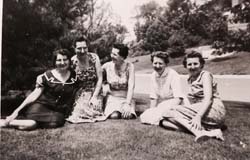 In this 1960 snapshot, the five daughters are arranged in their birth order from left to right: Anna Bower Mylander, Alice Bower Jesson, Georgia Bower O’Brien, Henrietta Bower Kuntz, and Wilda Bower Drake.
In this 1960 snapshot, the five daughters are arranged in their birth order from left to right: Anna Bower Mylander, Alice Bower Jesson, Georgia Bower O’Brien, Henrietta Bower Kuntz, and Wilda Bower Drake.
Of the five Bower daughters, Alice (Mrs. Frederick) Jesson had a long and successful career as Director of Restaurants and Cafeterias of the F. & R. Lazarus Company.
(Photos and write-up courtesy of Jim Drake) Note: there is one more image of the Bowers’ cart here.
Stop 18
Wednesday, July 15th, 2015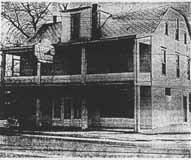 In my book, I have a wonderful photo of the inside of Stop 18, an interurban stop containing a mom-and-pop grocery store. Located at approximately 5534 North High Street, it reopened in 1934 as the Stop 18 Inn, owned by Jacque Criticos. The tavern continued to operate until it was sold to Hudson Oil in 1968.
In my book, I have a wonderful photo of the inside of Stop 18, an interurban stop containing a mom-and-pop grocery store. Located at approximately 5534 North High Street, it reopened in 1934 as the Stop 18 Inn, owned by Jacque Criticos. The tavern continued to operate until it was sold to Hudson Oil in 1968.
According to the Dispatch‘s Johnny Jones, canoeists from the Olentangy Canoe Club (presumably the one located in Olentangy Park) used to row their canoes from their clubhouse up the river to Stop 18. That location on the river also served as a popular skinny-dipping location.
Three fun articles are attached:
An announcement of its opening, in the Columbus Star June 10 1934, p.28
An article about its closing in the Columbus Dispatch January 28, 1968, p.21a
An article about its naming and history in the Columbus Dispatch, January 29, 1968 p.3b
Have a Bash
Monday, June 15th, 2015 From Unforgettable Columbus, volume 2: “Although Herb Bash is not considered a pro, he did give lessons and was considered a pretty fair golfer. [Early on, he leased Indian Springs Golf Course.] In 1948 he opened a unique golfing complex on W. Dodridge St. between Olentangy River and the Olentangy River Rd. These 60 acres consisted of an 18-hole golf course and a large driving range. He sold the land in 1962 to Chemical Abstracts and moved his entire operation to just beyond Rte 161 on Dublin Road…The driving range on Dodridge was a place where many a Columbus duffer sharpened his game. Bash died in 1979 at the age of 86.”
From Unforgettable Columbus, volume 2: “Although Herb Bash is not considered a pro, he did give lessons and was considered a pretty fair golfer. [Early on, he leased Indian Springs Golf Course.] In 1948 he opened a unique golfing complex on W. Dodridge St. between Olentangy River and the Olentangy River Rd. These 60 acres consisted of an 18-hole golf course and a large driving range. He sold the land in 1962 to Chemical Abstracts and moved his entire operation to just beyond Rte 161 on Dublin Road…The driving range on Dodridge was a place where many a Columbus duffer sharpened his game. Bash died in 1979 at the age of 86.”
According to Bill Case’s web site, “former South High coach Herb Bash … made his living in the golf industry. Herb and his wife owned the Berwick Golf Course, a public facility located on the city’s southeast side. Herb helped grow the game at Berwick by conducting numerous golf clinics for the city’s youths. Shortly after joining The Elks’ in 1928, Bash, in partnership with Bugs Raymond, opened another golf course- Indian Springs, opposite Henderson Road on the east side of High Street. Herb later added the “Bash Driving Range” in Dublin to his collection of entrepreneurial golf activities. Like many of his compatriots at Elks’-Wyandot, Herb Bash could golf his ball. Prior to joining The Elks’, he won Dublin Road’s club championship. Herb was also a mainstay of the 1932 Wyandot golf team which won the inter-club championship.” [Image courtesy of Bill Case.]
Olentangy Park Redux
Friday, May 15th, 2015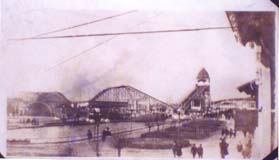 I never tire of seeing old images of Clinton- ville. Collector Galen Gonser shared these 1920 images with us. Admittedly they are taken with a simple box camera, but still, what’s not to like? (Photos courtesy of Galen Gonser.)
I never tire of seeing old images of Clinton- ville. Collector Galen Gonser shared these 1920 images with us. Admittedly they are taken with a simple box camera, but still, what’s not to like? (Photos courtesy of Galen Gonser.)
The first image below is Chute the Chutes at Olentangy Park.
We don’t know who these gentlemen are.
These images are taken looking north from Dodridge Bridge up the Olentangy River toward Olentangy Park–the second of the pair is a close-up.
For additional photos, search “Olentangy Park” on this web site.
Finding Nelson Evans (blog)
Tuesday, April 14th, 2015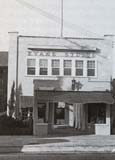 Clintonville resident Tom Thacker has been researching former Clintonville resident Nelson Evans, who lived at the end of East North Broadway near the railroad tracks between 1891 and 1910. The Evans family evenutally moved to Hollywood, and Mr. Evans became a notable photographer. Check out Tom’s blog detailing his search for Mr. Evans here.
Clintonville resident Tom Thacker has been researching former Clintonville resident Nelson Evans, who lived at the end of East North Broadway near the railroad tracks between 1891 and 1910. The Evans family evenutally moved to Hollywood, and Mr. Evans became a notable photographer. Check out Tom’s blog detailing his search for Mr. Evans here.
